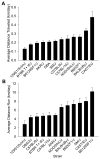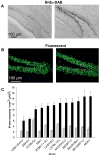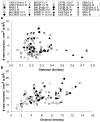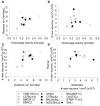Genetic influences on exercise-induced adult hippocampal neurogenesis across 12 divergent mouse strains
- PMID: 21223504
- PMCID: PMC3139814
- DOI: 10.1111/j.1601-183X.2010.00674.x
Genetic influences on exercise-induced adult hippocampal neurogenesis across 12 divergent mouse strains
Abstract
New neurons are continuously born in the hippocampus of several mammalian species throughout adulthood. Adult neurogenesis represents a natural model for understanding how to grow and incorporate new nerve cells into preexisting circuits in the brain. Finding molecules or biological pathways that increase neurogenesis has broad potential for regenerative medicine. One strategy is to identify mouse strains that display large vs. small increases in neurogenesis in response to wheel running so that the strains can be contrasted to find common genes or biological pathways associated with enhanced neuron formation. Therefore, mice from 12 different isogenic strains were housed with or without running wheels for 43 days to measure the genetic regulation of exercise-induced neurogenesis. During the first 10 days mice received daily injections of 5-bromo-2'-deoxyuridine (BrdU) to label dividing cells. Neurogenesis was measured as the total number of BrdU cells co-expressing NeuN mature neuronal marker in the hippocampal granule cell layer by immunohistochemistry. Exercise increased neurogenesis in all strains, but the magnitude significantly depended on genotype. Strain means for distance run on wheels, but not distance traveled in cages without wheels, were significantly correlated with strain mean level of neurogenesis. Furthermore, certain strains displayed greater neurogenesis than others for a fixed level of running. Strain means for neurogenesis under sedentary conditions were not correlated with neurogenesis under runner conditions suggesting that different genes influence baseline vs. exercise-induced neurogenesis. Genetic contributions to exercise-induced hippocampal neurogenesis suggest that it may be possible to identify genes and pathways associated with enhanced neuroplastic responses to exercise.
© 2011 The Authors. Genes, Brain and Behavior © 2011 Blackwell Publishing Ltd and International Behavioural and Neural Genetics Society.
Figures




Similar articles
-
Mouse genetic differences in voluntary wheel running, adult hippocampal neurogenesis and learning on the multi-strain-adapted plus water maze.Behav Brain Res. 2015 Mar 1;280:62-71. doi: 10.1016/j.bbr.2014.11.030. Epub 2014 Nov 27. Behav Brain Res. 2015. PMID: 25435316 Free PMC article.
-
Functional analysis of neurovascular adaptations to exercise in the dentate gyrus of young adult mice associated with cognitive gain.Hippocampus. 2009 Oct;19(10):937-50. doi: 10.1002/hipo.20543. Hippocampus. 2009. PMID: 19132736 Free PMC article.
-
Induction of c-Fos, Zif268, and Arc from acute bouts of voluntary wheel running in new and pre-existing adult mouse hippocampal granule neurons.Neuroscience. 2011 Jun 16;184:16-27. doi: 10.1016/j.neuroscience.2011.03.072. Epub 2011 Apr 7. Neuroscience. 2011. PMID: 21497182 Free PMC article.
-
Mechanisms underlying the effect of voluntary running on adult hippocampal neurogenesis.Hippocampus. 2023 Apr;33(4):373-390. doi: 10.1002/hipo.23520. Epub 2023 Mar 9. Hippocampus. 2023. PMID: 36892196 Free PMC article. Review.
-
Running is rewarding and antidepressive.Physiol Behav. 2007 Sep 10;92(1-2):136-40. doi: 10.1016/j.physbeh.2007.05.015. Epub 2007 May 21. Physiol Behav. 2007. PMID: 17561174 Free PMC article. Review.
Cited by
-
Pros and Cons of Clinically Relevant Methods to Assess Pain in Rodents.Neurosci Biobehav Rev. 2019 May;100:335-343. doi: 10.1016/j.neubiorev.2019.03.009. Epub 2019 Mar 15. Neurosci Biobehav Rev. 2019. PMID: 30885811 Free PMC article. Review.
-
Comparison of Adult Hippocampal Neurogenesis and Susceptibility to Treadmill Exercise in Nine Mouse Strains.Neural Plast. 2017;2017:5863258. doi: 10.1155/2017/5863258. Epub 2017 Dec 17. Neural Plast. 2017. PMID: 29391953 Free PMC article.
-
Physical exercise alleviates ADHD symptoms: regional deficits and development trajectory.Neurotox Res. 2012 Feb;21(2):195-209. doi: 10.1007/s12640-011-9260-0. Epub 2011 Aug 18. Neurotox Res. 2012. PMID: 21850535
-
Aerobic fitness, hippocampal viscoelasticity, and relational memory performance.Neuroimage. 2017 Jun;153:179-188. doi: 10.1016/j.neuroimage.2017.03.061. Epub 2017 Mar 30. Neuroimage. 2017. PMID: 28366763 Free PMC article.
-
Running Changes the Brain: the Long and the Short of It.Physiology (Bethesda). 2017 Nov;32(6):410-424. doi: 10.1152/physiol.00017.2017. Physiology (Bethesda). 2017. PMID: 29021361 Free PMC article. Review.
References
-
- Bednarczyk MR, Aumont A, Decary S, Bergeron R, Fernandes KJ. Prolonged voluntary wheel-running stimulates neural precursors in the hippocampus and forebrain of adult CD1 mice. Hippocampus. 2009;19:913–927. - PubMed
-
- Bequet F, Gomez-Merino D, Berthelot M, Guezennec CY. Exercise-induced changes in brain glucose and serotonin revealed by microdialysis in rat hippocampus: effect of glucose supplementation. Acta Physiol Scand. 2001;173:223–230. - PubMed
-
- Chaddock L, Erickson KI, Prakash RS, Kim JS, Voss MW, Vanpatter M, Pontifex MB, Raine LB, Konkel A, Hillman CH, Cohen NJ, Kramer AF. A neuroimaging investigation of the association between aerobic fitness, hippocampal volume and memory performance in preadolescent children. Brain Res. 2010 In press. - PMC - PubMed
Publication types
MeSH terms
Grants and funding
LinkOut - more resources
Full Text Sources
Molecular Biology Databases

